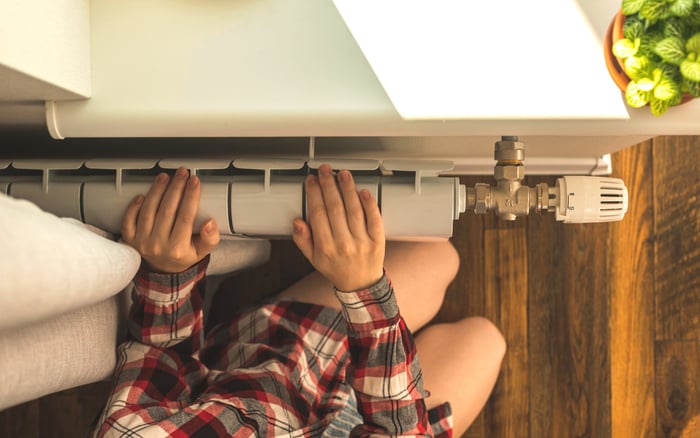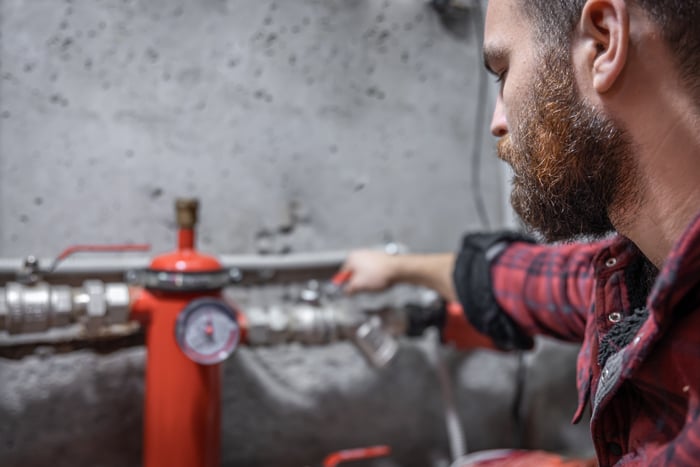
The pressure drop in a central heating system in a closed circuit is a problem that can disrupt the operation of the entire heating system. A drop in water pressure causes poorer heat circulation, leading to uneven heating of radiators and a reduction in system efficiency. The main problems of the heating system include leaks, valve failures, or issues with the circulation pump. To maintain comfort and efficiency of the central heating system, it is worth knowing the most common difficulties and ways to solve them.
What will you learn from this article?
In the case of pressure drops in the central heating system, it is worth knowing the mechanisms of their formation and effective control methods. Thanks to our knowledge, you will learn how to avoid many problems that could affect the operation of your heating system during the season. Additionally, you will read about:
- Recognizing the most common causes of pressure drop in a closed heating system.
- Why does regular water replenishment prevent problems?
- What preventive actions should be taken to maintain proper pressure in the heating system?
- In what situations is specialist intervention necessary.
Learn the typical causes of pressure drop in a heating system
The pressure drop in a closed central heating system can be caused by many factors that directly affect its operation. Here are the most common causes:
- Leaks in the system – even small leaks from pipes, valves, or central heating connections can lead to a gradual decrease in the amount of water in the circuit, which in itself causes a drop in pressure throughout the system. Ignoring small leaks over time leads to greater pressure losses.
- Presence of air in the system – air can enter the system due to improper filling of the installation, interruptions in system operation, or valve problems. It causes disruptions in water flow and uneven heating of radiators.
- Problems with the expansion vessel – the expansion vessel stabilizes the pressure in the system by absorbing excess water when pressure rises. In case of damage or overflow of the vessel, the system's ability to normalize pressure fluctuations decreases.
- Improper operation of the safety valve – the safety valve protects the installation from excessive pressure increases. If it is damaged or set to improper values, excessive water discharge may occur, lowering the pressure and forcing more frequent water replenishment in the closed circuit.
- Problems with the circulation pump – proper operation of the pump is extremely important, especially in larger installations. If it doesn't work correctly, water circulation is disrupted, making it difficult to maintain appropriate pressure throughout the heating system.

What you need to know about the central heating system in a closed circuit?
The expansion vessel is one of the important elements of the central heating system, which is responsible for stabilizing pressure in the closed circuit. Its function is to absorb excess water that appears when pressure increases and release it when it drops. In case of damage or overflow, the system loses its ability to compensate for pressure changes, resulting in fluctuations and reduced efficiency of the entire system.
Another important part of the heating system is the safety valve, which protects the structure from excessive pressure increases. If it malfunctions or is set to incorrect values, excessive water discharge may occur, leading to a pressure drop. Regular inspection and maintenance of the safety valve, as well as regular water filling to the radiators, is one of the basic steps to prevent poor system operation.
Water pressure in central heating – monitoring and maintaining the correct level
Ensuring stable pressure in the central heating system requires systematic monitoring of the entire circuit and taking maintenance actions when necessary. It is important to check water levels and pressure using a manometer. The recommended value in a closed heating system is usually between 1 and 2 bars, although the exact value depends on the specification of the system. If the pressure drops, it's worth checking for leaks or other irregularities that could affect the system's efficiency. Sometimes it's even necessary to add water to the central heating.
Monitoring water in radiators
Regular filling of the closed central heating system is a necessity as much as checking individual elements of such a system. This procedure is very important because it allows you to maintain stable pressure in the pipes. To avoid introducing air into the system, water should be added slowly, and then the radiators should be vented. It is worth remembering that proper performance of this action ensures even heating of radiators.
Filling the central heating system – preventing problems
Proper prevention allows avoiding many problems with home heating installations. Regular venting of radiators enables the removal of excess air from the system and prevents water flow disruptions. This should be done with the circulation pump turned off, as this avoids circulation issues.
Checking the water level in the expansion vessel and maintaining correct pressure (it should not be too low) are other actions that influence the smooth functioning of the entire system. In situations where air enters the installation, a specialist should be consulted to check the sealing and verify if, for example, a non-return valve is properly secured. They will also evaluate the shut-off valve and the condition of the expansion vessel.

When should you call a professional for a heating appliance?
If low water pressure in your home is a recurring problem, and attempts to solve it are ineffective, professional help may be necessary. For example, if your system is leaking, it requires thorough diagnostics, as this is essential for its continued safe operation.
Other symptoms that may indicate the need for a professional inspection include difficulty in maintaining pressure despite adding water to the heating system and unusual noises coming from the system.
Steps you can take on your own
- To check water pressure on your own, purchase a manometer and regularly monitor its level. It should not be too low or too high.
- Replenish water in the system – do this slowly to avoid introducing air.
Taking care of these basic aspects of heating system operation extends its lifespan and, most importantly, prevents many difficulties associated with its daily use.
Don't forget to check pressure in a closed heating system!
The pressure drop in a closed heating system can be caused by various factors, from minor leaks to complications with the expansion vessel or safety valves. To ensure thermal comfort and proper system operation, regular monitoring of valve condition and water level, as well as proper venting of radiators, is crucial.
If, however, despite these actions, the pressure drop problem persists, it is worth seeking help from a professional who can accurately diagnose the cause and implement appropriate solutions.


















